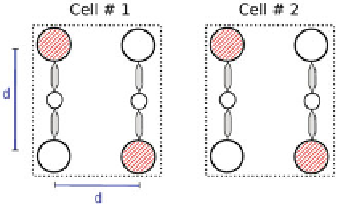Information Technology Reference
In-Depth Information
thus transmitting or processing the information. To avoid metastability prob-
lems, the so-called adiabatic mode of switching has been devised and a single
cell must dispose of six dots [
2
-
4
]. Consequently a molecule must have three
redox centers, as sketched in Fig.
2
. The third redox center is used to encode the
logic NULL state which corresponds to the charge occupying the central dot.
A molecule with three active dots reproduces a half- QCA cell and can be com-
pleted to form a whole cell aligning another molecule on its side (Fig.
3
). The two
half-cells interact through the electrostatic forces among the free charges which
tend to localize within each molecule in order to minimize the relative potential
energy. This configuration clearly recalls the theoretical QCA structures based
on squared cells able to capture charges in the dots along the diagonal of the
square [
1
].
Fig. 3.
Complete QCA cell and interaction between cells (top view).
1.2
Candidates Molecules
On the applicative point of view, the greatest effort in developing molecular QCA
cells is in the quest for molecules with proper features as computing elements.
The ideal molecule, indeed, encompasses many properties which reveal to be
strictly necessary.
Many molecules present geometrical structures which limit the molecule itself
to be used only in the gas phase or in solution; this is mainly due to the lack of a
binding element for deposition on substrates. Consequently, practical QCA mole-
cules should pose the functional groups that allow attachment and orientation
on a surface.
As already mentioned before, a suitable molecule should have at least three
redox centers in order to encode the NULL state, introduced for energy and
stability reasons.
Finally, a simple and reliable mechanism is necessary to set and read molec-
ular states at the edge of a molecular array. Devising solutions to this problem is
a major issue, given the actual absence of instruments capable of revealing the
motion of single charges on nanometer scale.

Search WWH ::

Custom Search